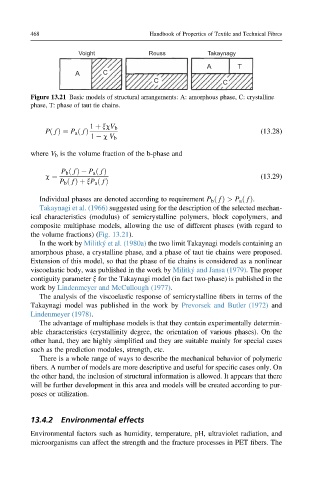Page 495 - Handbook of Properties of Textile and Technical Fibres
P. 495
468 Handbook of Properties of Textile and Technical Fibres
Voight Reuss Takaynagy
A T
A C
C C
Figure 13.21 Basic models of structural arrangements: A: amorphous phase, C: crystalline
phase, T: phase of taut tie chains.
1 þ xcV b
Pð f Þ¼ P a ð f Þ (13.28)
1 c V b
where V b is the volume fraction of the b-phase and
P b ð f Þ P a ð f Þ
c ¼ (13.29)
P b ð f Þþ xP a ð f Þ
Individual phases are denoted according to requirement P b ð f Þ > P a ð f Þ.
Takaynagi et al. (1966) suggested using for the description of the selected mechan-
ical characteristics (modulus) of semicrystalline polymers, block copolymers, and
composite multiphase models, allowing the use of different phases (with regard to
the volume fractions) (Fig. 13.21).
In the work by Militký et al. (1980a) the two limit Takaynagi models containing an
amorphous phase, a crystalline phase, and a phase of taut tie chains were proposed.
Extension of this model, so that the phase of tie chains is considered as a nonlinear
viscoelastic body, was published in the work by Militký and Jansa (1979). The proper
contiguity parameter x for the Takaynagi model (in fact two-phase) is published in the
work by Lindenmeyer and McCullough (1977).
The analysis of the viscoelastic response of semicrystalline fibers in terms of the
Takaynagi model was published in the work by Prevorsek and Butler (1972) and
Lindenmeyer (1978).
The advantage of multiphase models is that they contain experimentally determin-
able characteristics (crystallinity degree, the orientation of various phases). On the
other hand, they are highly simplified and they are suitable mainly for special cases
such as the prediction modules, strength, etc.
There is a whole range of ways to describe the mechanical behavior of polymeric
fibers. A number of models are more descriptive and useful for specific cases only. On
the other hand, the inclusion of structural information is allowed. It appears that there
will be further development in this area and models will be created according to pur-
poses or utilization.
13.4.2 Environmental effects
Environmental factors such as humidity, temperature, pH, ultraviolet radiation, and
microorganisms can affect the strength and the fracture processes in PET fibers. The

